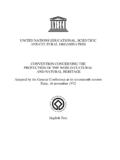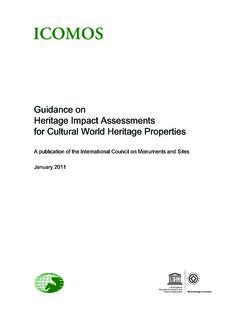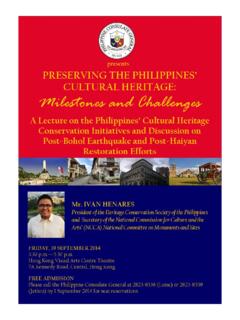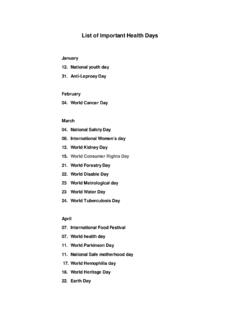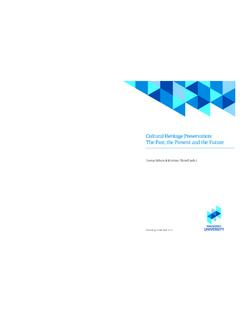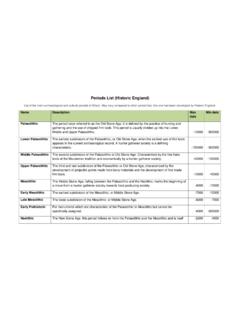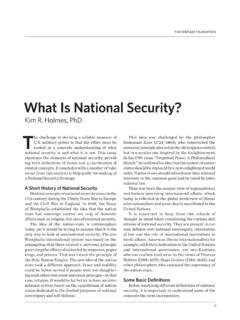Transcription of PROTECTING CULTURAL HERITAGE
1 PROTECTING . CULTURAL HERITAGE . AN IMPERATIVE FOR HUMANITY. ACTING TOGETHER AGAINST DESTRUCTION AND. TRAFFICKING OF CULTURAL PROPERTY. BY TERRORIST AND ORGANIZED CRIME GROUPS. United Nations 22 September 2016. CULTURAL HERITAGE is a reflection of human history, civilization and the coexistence of multiple peoples and their ways of life. Its protection is a shared responsibility of the international community, in the interest of future generations.. Paolo Gentiloni, Minister of Foreign Affairs and International Cooperation of Italy Decades from now, generations will judge us by the courage we showed and actions we took to preserve their and our HERITAGE and culture. Preserving this HERITAGE is the collective duty of this generation to many generations to come.
2 Nasser Judeh, Deputy Prime Minister and Minister of Foreign Affairs and Expatriates of Jordan As conflicts remain aflame across the world , we must join forces to protect CULTURAL HERITAGE from illicit trafficking, the collateral damage of war and intentional destruction. Culture is a catalyst for dialogue, reconciliation and peace it must become part of peacebuilding, built early into security and humanitarian considerations.. Irina Bokova, Director-General of UNESCO. Effective cooperation at the national and international levels among different stakeholders is crucial to PROTECTING and preserving our shared CULTURAL HERITAGE , as well as ending all forms of trafficking in CULTURAL property.. Yury Fedotov, Executive Director of UNODC. Member states can act to deter the demand for illicitly obtained CULTURAL HERITAGE items in destination markets.
3 It is our duty to protect the CULTURAL HERITAGE of mankind, as the most amazing symbol of our past, in order to protect our future.. J rgen Stock, Secretary General of INTERPOL. 2. PROTECTING CULTURAL HERITAGE : An Imperative for Humanity CONTENTS. BACKGROUND 6. SUGGESTED KEY ACTIONS 12. A. International level 13. B. National level 14. C. Key Actions with regard to CULTURAL property from areas affected by armed conflict 16. ANNEXES 18. ANNEX 1 - Report of the three meetings 19. A. The first Meeting, held on March 2, 2016 19. B. The second meeting, held on April 28, 2016 20. C. The third meeting, held on May 27, 2016 21. ANNEX 2 - List of main official documents on CULTURAL HERITAGE protection 22. Treaties and declarations 22. UN bodies' resolutions 22. UNESCO bodies' decisions and recommendations 23.
4 INTERPOL 2016. For further information, please contact: The Permanent Mission of Italy to the UN: +1 (646) 840 5336. The Permanent Mission of the Hashemite Kingdom of Jordan to the UN: +1 212 832 0836. UNESCO: +1 212 963 5995. UNODC: +1 212 963 5698. INTERPOL: +1 917 367 3463. 3. INTRODUCTION. In light of the increasing number of international crimes related to the looting and trafficking of CULTURAL HERITAGE , a first international response was the Convention on the Means of Prohibiting and Preventing the Illicit Import, Export and Transfer of Ownership of CULTURAL Property established by UNESCO in 1970. Today, these crimes are increasingly linked to international criminal activity including the financing of terrorist groups. During 2015 and 2016, the Permanent Missions of Italy and Jordan chaired a series of meetings at UN Headquarters in New York dedicated to different aspects of the protection of CULTURAL HERITAGE .
5 This initiative was organized together with INTERPOL, UNESCO, and UNODC, who retain the related and complementary expertise on the issues. To ensure the protection of CULTURAL HERITAGE , Italy, Jordan, INTERPOL, UNESCO, and UNODC. have drawn up a list of suggested key actions, which can be found in this brochure. These are based on the outcomes of these meetings, the comprehensive guidelines adopted to support the implementation of the 1970. UNESCO Convention and the UN Convention on Transnational Organized Crime, and the priorities of experts working in the field. Hydria Apula with red figures referring to the Myth of Andromeda (350-340 ) that was illicitly excavated in Italy and illicitly exported. It was recovered in Geneva (Switzerland) in 2010 by the Italian Carabinieri.
6 4. PROTECTING CULTURAL HERITAGE : An Imperative for Humanity 5. BACKGROUND. 6. PROTECTING CULTURAL HERITAGE : An Imperative for Humanity 1. The role of organized criminal and terrorist CULTURAL HERITAGE and CULTURAL properties groups is of particular concern. They have have been destroyed, looted and trafficked entered into all forms of trafficking in CULTURAL throughout history, particularly during conflict property and related offences, illegally moving and post-conflict situations. items through diverse markets, such as auction houses and the Internet. Trafficking has The international trade in antiquities and also become an important means of money artefacts, both legal and illegal, was traditionally laundering and a source of financing for terrorist handled by specialists working within a trusted groups.
7 It is sometimes enabled through the network and following consolidated methods. support of insiders such as corrupt customs or Valuable items were identified and selected, border officials, law enforcement officers, and appropriate transportation arranged, and dealers in art and antiquities. border crossings sometimes facilitated by forged documents, hidden compartments, or pay-offs 3. to corrupt officials. A network of confidential There is heightened concern today over the partners created a paper trail of documents unprecedented scale of organized looting that established contracts, fees and tax liability and trafficking often combined with the while shielding the merchants from discovery. intentional destruction of CULTURAL HERITAGE Such practices have become easier and more sites especially in the context of crises in the common today thanks to globalized trade, new Middle East.
8 While the perpetrators of these means of shipment, and the protected sites and acts benefit from the profits of looting, which wealth of contacts offered by the Internet. support their recruitment efforts and strengthen their operational capacity, they also seem 2. resolved to eradicate CULTURAL diversity from the In recent decades, organized groups criminal territories under their control. In addition to the and otherwise have entered the picture, loss of irreplaceable CULTURAL HERITAGE , this has providing professional services to a growing led to heinous violations of human rights and number of sellers and collectors. The volume fundamental freedoms. and value of transactions have risen, with prices and profit margins skyrocketing, while the illegal 4. trading of artefacts has steadily increased.
9 Because of their transnational dimension, CULTURAL property is being unlawfully excavated, trafficking offences can involve multiple stolen, looted and exported or imported with national jurisdictions. Trafficked items are looted the help of sophisticated modern technologies. in one country and travel across several others before reaching their final destination. When items are intercepted, local authorities do not always have the necessary expertise to identify them, assess their value, or grasp the scale of the criminal operation behind a single act of trafficking. National responses at the legislative, institutional and law enforcement levels have thus proved insufficient, and these threats require action at the regional or global level. Nimrud 7. 5. 7.
10 In the late 1960s and early 1970s, thefts On the broader question of the protection of were increasing both in museums and at CULTURAL property in armed conflicts, the 1954. archeological sites. In this context, the first Hague Convention for the Protection of CULTURAL national response was the formation, in Italy, of Property in the Event of Armed Conflict, together the Carabinieri TPC, the world 's first police force with its two (1954 and 1994) Protocols, specialized in the protection of CULTURAL property. introduced a series of obligations for its States At the international level, the first response to Parties. These included peacetime activities, such this situation was the Convention on the Means as the creation of special units within national of Prohibiting and Preventing the Illicit Import, armies to protect CULTURAL property, and war-time Export and Transfer of Ownership of CULTURAL provisions, such as not targeting CULTURAL property Property adopted by UNESCO in 1970.











